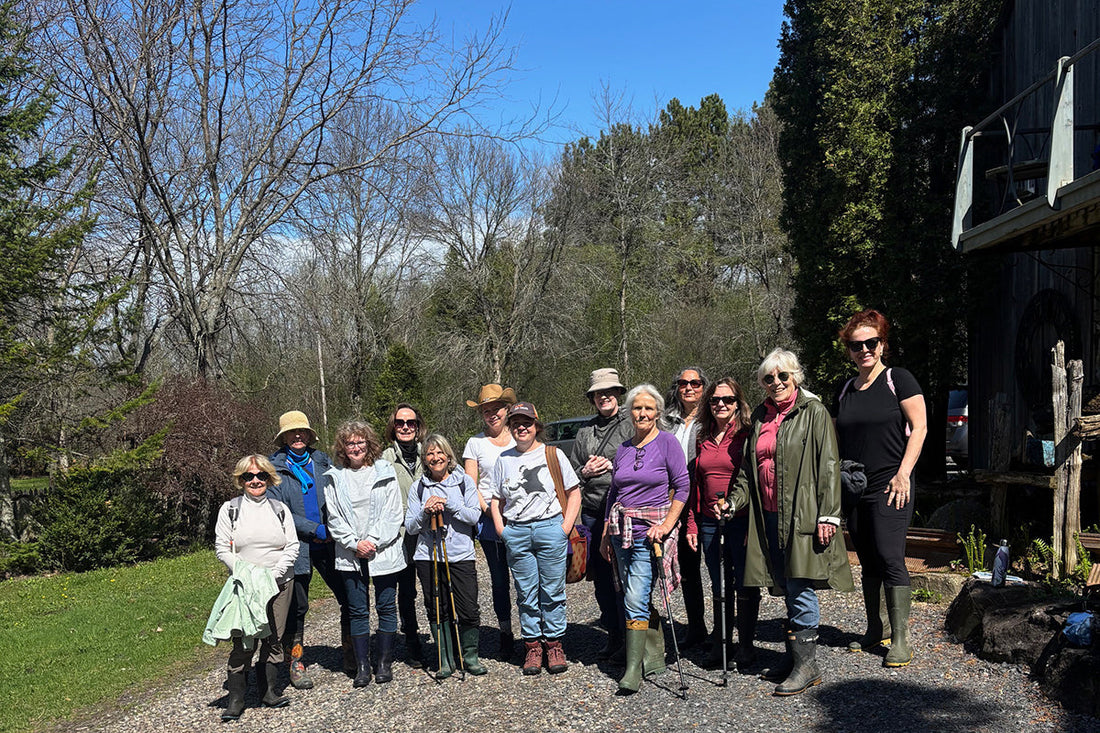
Gone in a Flash, Rooted in Wonder
Share
I had the privilege, with 12 other members, of the Hudson Garden Club to do a walking tour with Dr Frieda Beauregard on May 10 through the lands of Creek 53 Conservation Trust in Hudson.
An expansive part of Hudson comprising of wetlands, grasslands and forests and a large escarpment. Being a fierce environmentalist and land donor to conservation myself I was intrigued and excited to explore and view the jewels of early Spring.
Each spring, something quietly magical unfolds in the woods-if you're lucky enough to witness it. I'm talking about the spring ephemerals: delicate wildflowers that bloom brightly and briefly before fading away, making room for the taller, later plants of the season. Their timing is everything. They slip in just as the light returns and the chill lifts, taking advantage of a narrow window before the forest canopy closes overhead. Blink, and you might miss them.
A mix of open fields, shaded woods and escarpment was alive with early blooms and quiet rustle of new life. It reminded me why I fell in love with these plants in the first place—not just for their beauty, but for the sense of timing and mystery they bring to the season.
 |
 |
 |
The spring ephemerals we encountered on our walk were among the most fleeting, delicate, vibrant, showy, abundant, and delightfully unusual.
Their presence often signals high-quality, undisturbed mixed forests with rich, loamy soils. One of the earliest to bloom is Claytonia caroliniana also known as Spring Beauty, a rightfully so and befitting name with diminutive, striped pink-and-white flowers that open only in sunlight and often when snow is still melting.

A close contender is Hepatica nobilis var. acuta, known by many common names describing its sharp-lobed leaf form.
Growing in south-facing ground where soil warms early the Liverleaf Anemone from the Buttercup family is quite fleeting in bloom and forming prominent clumps. As the photo demonstrates we were too late for the bloom but we could not mistake the species from its unique foliage.

One cannot help but notice the showy display of star-shaped yellow, nodding bells of Erythronium americanum or commonly known as Yellow Trout Lilly or Dogtooth Violet, with spotted or mottled leaves!
It forms dense colonies in rich, moist woodlands. One peculiarity I have noticed is that not all plants bloom but that does not take away from its flamboyance.


Dicentra cucullaria (Dutchman’s Breeches) follows the above line-up coming up in late April early May. I just adore this transient beauty not only for its “bloomer-shaped” fragile blooms but also for its intricately-laced grey-green foliage veiling the woodland grounds.

The next group of Spring ephemerals are the charismatic Trilliums. We were fortunate to see all three represented in Creek 53.
Trillium erectum, the Red Trillium, also known as Red Robin, is a solitary marvel perched on erect stems and accentuated by whorls of diamond-shaped leaves. Sometimes it demands attention as we see below.


Trillium grandiflorum, commonly known as the large-flowered trillium. Its showy white flowers, often variable in petal shape, gradually blush pink with age. This Trillium plays a key role in early-season pollination. It seems to love open spaces and moist exposed banks.


The third member of the Trillium family is Trillium undulatum. The most graceful of all three in the woods with a dainty ephemeral beauty. Although it has a wide range of habitat it is trickier to spot due to its particular needs of soil. It likes shade, moisture and acidity. I am always enthralled when I spot it! The photo below captures its beauty perfectly, no need to embellish any more.

In conclusion, while these Ghosts of Spring do vanish, many leave behind quiet reminders of their brief visit—colourful seed pods, shifting foliage, and the lingering memory of their colourful appearance. Their short life cycle plays an important role in forest ecosystems, marking seasonal transitions and supporting early pollinators and seed dispersers.
Though not technically spring ephemerals, one cannot minimize the importance of ferns in the woods and understory of forests. Ferns provide a natural lush green backdrop palette such as Matteuccia struthiopteris or the Fiddlehead fern.


Some of the other spring beauties we saw on the walk:
The sculptural Arisaema triphyllum or Jack-in-the-Pulpit.

The elegant Uvularia sessilifolia or Sessile Bellwort.

Viola sororia or the Common Blue Violet that brightens the forest floor.

And last but not least, The luxuriant greenery of Maianthemum racemosum or Solomon’s Plume.

Maria Galletti
Hudson Garden Club
Images: Maria Galletti and Stephane Hogue
